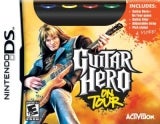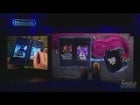To say that Guitar Hero's impact on popular culture has been significant is a bit of an understatement. Activision's music franchise has helped to make gaming a more accessible and interactive experience, to the point that it's not uncommon to see people basing their parties around a night of gaming. Of course, like any popular form of media, consumers can get too much of a good thing, either through official releases or copycats. Guitar Hero Rocks the 80s felt like a rushed expansion, and it remains to be seen if the upcoming Aerosmith release will be able to tide people over until Guitar Hero IV hits stores later this year.
While the series runs the risk of oversaturating an already crowded market on the home consoles, there really isn't a lot of competition on the handhelds. This may be a big reason we're seeing the release of Guitar Hero: On Tour, the first GH title on the Nintendo DS. Why isn't there more competition, you ask? It could be due to the fact that it's tough to really get into a music game when you're not playing an instrument (well, a plastic facsimile of one) and rocking out. In an effort to recreate the franchise's unique controller, developer Vicarious Visions has not only created the game itself, it's designed a brand-new input.
Before we get into the peripheral too much, we should probably explain that this is still the same Guitar Hero we all know and love. You'll need to hit color-coded notes as they stream down from the top of the screen, making your way through a variety of increasingly more difficult tracks. Playing through the game's career mode is the only way to unlock new tracks, and it should be noted that all of them can be unlocked by playing on any of the game's four difficulties. As you play, you'll earn money that can then be used to buy new outfits or guitars for your character. Unfortunately, there aren't any extra songs to purchase, something that extended the life of many of the console titles.
The game's big hook is its peripheral, which is actually quite impressive at first glance. Sliding over the back of the DS and plugging into the GBA port, the guitar attachment is actually quite responsive and easy-to-use... for a while. Ultimately, your wrist will probably start aching, even when you're holding it as you're supposed to (there are several ergonomic warnings that are shown every time you start up). You'll either end up bending your wrist awkwardly or twisting your neck to view the screen at the correct angle, so it definitely pays to take frequent breaks. Worst of all, shifting your hand too much could jar the peripheral loose mid-song, and it can't simply be plugged back in. Nope, you'll need to restart the game completely, quite possibly while cursing.
Ergonomic and design issues aside, the game does feel quite solid. Rather than strumming up and down on a bar, you'll use the included pick/stylus to strum a picture of a guitar on the touch screen. There are some issues during fast songs or on harder levels, as you'll need to lift the stylus from the screen and strum each note (strumming back and forth without lifting it acts as the whammy bar). The star power system isn't perfect either, as you'll need to make noise or blow in the microphone to turn it on. You can imagine how this works on noisy bus rides or similar areas, where you may end up inadvertently using it at inopportune moments.
These problems are softened a bit by the soundtrack, which is made up primarily of songs new to the franchise. The fact that many of them are master tracks is great, and even the covers sound decent (well, except for "La Grange"). There's a nice mix of classic rock staples (how could you not love playing the intro to "China Grove" by The Doobie Brothers?) and new tunes. However, the fact that there's only a total of 25 songs stings a little bit, as it won't take more than a few hours to play through them all. Unfortunately, we don't see any DLC in the game's future.
Thankfully, there are some multiplayer options to keep you busy after you've beaten the game a few times. The centerpiece of the competitive mode is the head-to-head battle that plays almost exactly like the one seen in Guitar Hero III. The difference here is that you'll need to perform tasks better-suited to the DS, such as dragging the stylus from one point to another to fix a string or blowing in the mic to put out a fire that's broken out on your guitar (don't ask). It's a fun mode, but we wonder if it will be played more than the face-off or co-op modes. It should also be noted that the online can be played via local ad-hoc only, but that you'll be able to battle against the CPU if you don't have any friends around.
In some ways, Guitar Hero: On Tour feels more like an experiment than a full-fledged game, as if Activision just wanted to see if it could be pulled off. Whether or not it succeeded is open to debate, as there are a number of issues that hurt the game. The guitar peripheral doesn't work as well as we had hoped, something that's could prove to be a major sticking point (after all, who wants to keep playing a game that hurts you?). Still, it's a solid entry in the franchise and gets points for innovation, so we're hopeful that this won't be the series' last foray into the handheld domain.





 Good
Good


